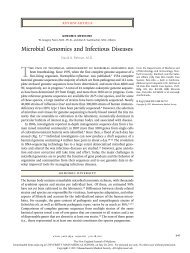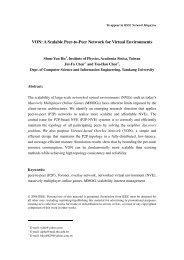3.1 MB - Evernote
3.1 MB - Evernote
3.1 MB - Evernote
Create successful ePaper yourself
Turn your PDF publications into a flip-book with our unique Google optimized e-Paper software.
Simulation Controller side<br />
52<br />
Implementation<br />
At the Simulation Controller side is the root package parallelJavaGpssSimulator. It<br />
contains the class Simulate, which is the application class that is used to start the<br />
parallel simulator. When run the Simulate class will load the configuration from<br />
command line arguments or the configuration file, it will also load and parse the<br />
simulation model file and then create an Active Object instance of the<br />
SimulationController class (the JavaDoc documentation for this class can be found in<br />
Appendix E). The SimulationController instance receives the configuration settings and<br />
the simulation model when its simulate() method is called. As a result of this call the<br />
SimulationController class will read the deployment descriptor file and create the<br />
required number of LogicalProcess instances at the specified nodes.<br />
Logical Process side<br />
The functionality of the Logical Processes is found in the package<br />
parallelJavaGpssSimulator.lp. This package contains the LogicalProcess class, the<br />
ParallelSimulationEngine class (the JavaDoc documentation for both can be found in<br />
Appendix E) and a few helper classes. The LogicalProcess instances are created as<br />
Active Objects by the Simulation Controller. After their creation the LogicalProcess<br />
instances receive the simulation model partitions and the configuration when their<br />
initialize() method is called. When all LogicalProcess instances are initialised then the<br />
Simulation Controller calls their startSimulation() method to start the simulation. Figure<br />
15 illustrates the communication flow between the Simulation Controller and the<br />
Logical Processes before and at the end of the simulation. The method calls just<br />
described can be found at the start of this communication flow. When the Simulation<br />
Controller detects that a confirmed simulation end has been reached then all Logical<br />
Processes are requested to end the simulation with a consistent state matching that<br />
confirmed simulation end using the endOfSimulationByTransaction() method. The<br />
Logical Processes will confirm when they reached the consistent simulation state after<br />
which the Simulation Controller will request the post simulation report details from<br />
each Logical Process. Further specific details about the implementation of the parallel<br />
simulator can be found in section 5.3.
















